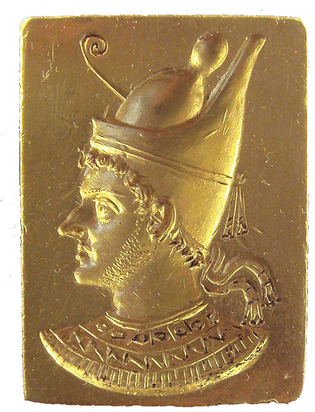
Wikimedia Commons
The Ptolemaic era is the focus of Professor Joe Manning and colleagues, who are studying the effects of extreme drought on the ancient Egyptians who experienced it. Above is a portrait of Ptolemy VI Philometor (d. 145 BCE), one of the many monarchs who ruled Egypt after Macedonian Greeks claimed it.
View full image
Imagine if a giant wallop of data suddenly became available to your field of study—data that could open it up for fine-tuned interdisciplinary explorations of events and correlations, season by season rather than by decade or century. To add drama, imagine your newfound trove of information is endangered.
This is what’s happening at the relatively new intersection of ancient history and paleoclimatology (the study of the climate before instruments recorded it). On the plus side, Joe Manning, a professor of classics and ancient history, is having more fun than a scholar of Ptolemaic Egypt should have without a license. By analyzing chemicals in cores of ancient ice, sediments, and other sources, Manning and his colleagues in the Yale Nile Initiative can more precisely determine when specific volcanoes erupted and how they may have affected the floods and droughts of one of the longest rivers on Earth.
Large volcanic eruptions throw sulfates into the stratosphere. Those particles reflect sunlight, cooling the planet, reducing rainfall, and producing drought. In long droughts, humans and animals move into new territories, creating ripe conditions for disease and rebellion. The members of the Yale Nile Initiative study the resulting effects: ancient famines, political upheavals, and even pandemics. “It’s a more nuanced kind of history,” says Manning.
But there’s a minus side. “Greenland and Antarctica are losing ice hugely fast, and there’s a race to get this million-year ice,” Manning explains. “It’s like if the Beinecke were burning. Imagine that.”
Using data from younger Greenland ice, Manning showed that eight of ten Egyptian uprisings between 297 BCE and 38 BCE occurred within two years of volcanic eruptions. Another paper he worked on made headlines in 2020 for showing the correlations between the Okmok volcanic eruption in Alaska in 43 BCE and the flooding, famine, and upheaval in the Mediterranean soon afterward—including the demise of the Roman Republic and the birth of the Roman Empire.
His team has linked Northern Hemisphere eruptions in the 160s BCE to Nile droughts and a lack of Indian Ocean monsoons, causing famine in Egypt and China. He marvels at the nearly identical letters that government officials in Egypt and China sent to their leaders, each of them desperate for aid to fend off famine.
Manning won a five-year $1.3 million grant from the National Science Foundation to study volcanism, hydrology, and social conflict. “We have one year of funding left, and we have 20 years of work,” he says. He’s now writing a book on climate throughout history, with a markedly optimistic tone despite alarming headlines on the pace of climate change. “We’re in this amazing age of science,” he says. “We have the tools. The problem is, our politics are still in the Bronze Age. But these are all soluble problems. It’s about mobilizing. It’s about teaching.”
With the past as an example, Manning remains hopeful. “Human societies have succeeded by being good at cooperation,” he says.
 loading
loading